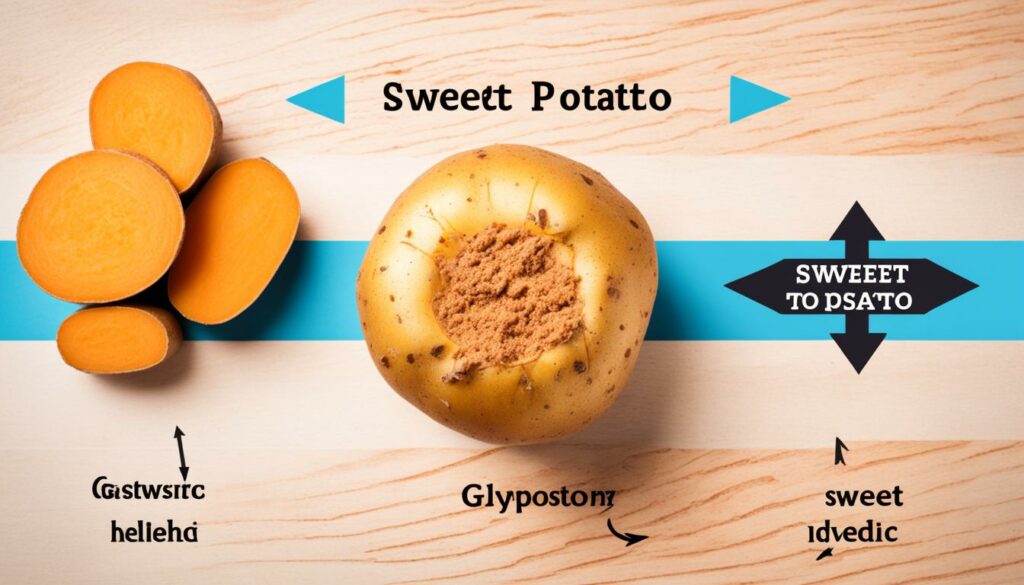When it comes to comparing the nutritional benefits of sweet potatoes and regular potatoes, it’s essential to understand the key differences between these two root vegetables. While both are nutritious, they do vary in terms of their nutritional composition and potential health benefits.
Sweet potatoes, which belong to the morning glory family, have a distinctive brown skin and vibrant orange flesh. On the other hand, regular potatoes come in various shades of brown, yellow, and red, with white or yellow flesh, and belong to the nightshade family.
In terms of overall nutrition, both sweet potatoes and regular potatoes offer valuable nutrients. They are excellent sources of fiber, carbohydrates, and vitamins B6 and C. However, sweet potatoes have a significant advantage over regular potatoes when it comes to vitamin A content. They are rich in this essential nutrient, which plays a crucial role in supporting eye health, immune function, and cell growth.
Furthermore, sweet potatoes are loaded with antioxidants that help combat cell damage and protect against chronic diseases. Regular potatoes, on the other hand, contain beneficial compounds called glycoalkaloids, which have been linked to various health benefits.
Key Takeaways:
- Sweet potatoes and regular potatoes belong to different plant families and offer distinct nutritional profiles.
- Sweet potatoes are high in vitamin A, antioxidants, and fiber, making them a healthy choice.
- Regular potatoes contain glycoalkaloids and are a good source of potassium.
- The decision on which one is healthier depends on specific nutritional needs and preferences.
- Incorporate both sweet potatoes and regular potatoes into a balanced diet for optimal nutrition.
Nutritional Comparison of Sweet Potato and Potato
When it comes to comparing the nutritional values of sweet potatoes and regular potatoes, it’s important to consider both their similarities and differences. Let’s take a closer look at how these two root vegetables stack up in terms of calories, macronutrients, vitamins, and minerals.
Calories and Macronutrients
Both sweet potatoes and regular potatoes are relatively similar in terms of calories and macronutrient composition. However, sweet potatoes tend to have slightly fewer calories compared to regular potatoes. Here is a breakdown of the approximate nutritional values for 100 grams of boiled sweet potato and boiled regular potato:
| Sweet Potato (boiled, 100g) | Regular Potato (boiled, 100g) | |
|---|---|---|
| Calories | 86 | 87 |
| Carbohydrates | 20.1 grams | 20.1 grams |
| Protein | 1.6 grams | 1.9 grams |
| Fat | 0.1 grams | 0.1 grams |
Note: Nutritional values may vary depending on the specific variety and cooking method.
Vitamins and Minerals
When it comes to vitamins and minerals, sweet potatoes and regular potatoes have their own unique profiles. Sweet potatoes are particularly rich in vitamin A, providing a whopping 107% of the Daily Value per 100 grams compared to only 0.1% in regular potatoes. They are also good sources of vitamins B6 and C.
On the other hand, regular potatoes are higher in potassium, providing 17% of the Daily Value per 100 grams compared to 10% in sweet potatoes. Potassium is an essential mineral that plays a crucial role in maintaining proper heart and muscle function.
Here is a comparison of the vitamin and mineral content in 100 grams of both boiled sweet potato and boiled regular potato:
| Sweet Potato (boiled, 100g) | Regular Potato (boiled, 100g) | |
|---|---|---|
| Vitamin A | 107% DV | 0.1% DV |
| Vitamin B6 | 0.2 mg | 0.3 mg |
| Vitamin C | 2.4 mg | 11.4 mg |
| Potassium | 230 mg | 429 mg |
Note: The values provided are approximate and can vary depending on factors such as variety and cooking method.
Plant Compounds
Both sweet potatoes and regular potatoes contain beneficial plant compounds that contribute to their overall nutritional value.
Sweet potatoes are particularly rich in antioxidants, which help protect the body against oxidative stress and may have anti-inflammatory properties. These antioxidants include beta-carotene, which gives sweet potatoes their vibrant orange color.
Regular potatoes, on the other hand, contain glycoalkaloids, which are natural defense compounds produced by the potato plant. Some studies suggest that these compounds may have beneficial effects on health, such as preventing the growth of cancer cells and reducing inflammation.
Incorporating both sweet potatoes and regular potatoes into your diet can provide a variety of important nutrients. Whether you prefer the vitamin A-rich and antioxidant properties of sweet potatoes or the potassium content of regular potatoes, both options offer significant health benefits.

Glycemic Index of Sweet Potato and Potato
The glycemic index (GI) is a measure of how quickly a food raises blood sugar levels. When it comes to sweet potatoes and regular potatoes, they have different GI values.
Sweet potatoes can have a GI ranging from 44 to 94, depending on the type and cooking method. Baked sweet potatoes tend to have a higher GI compared to boiled ones. On the other hand, regular potatoes also vary in their GI values. Boiled red potatoes have a GI of 89, while baked Russet potatoes have a GI of 111.
For individuals with diabetes or blood sugar issues, opting for sweet potatoes over regular potatoes may be beneficial due to their generally lower GI. However, it’s important to note that GI values can also vary within the same type of potato, depending on factors like portion size and cooking method.
Glycemic Index Comparison
| Potato Type | Glycemic Index |
|---|---|
| Sweet Potato (Baked) | 67 |
| Sweet Potato (Boiled) | 63 |
| Regular Potato (Boiled, Red) | 89 |
| Regular Potato (Baked, Russet) | 111 |
As shown in the table, sweet potatoes generally have a lower GI compared to regular potatoes. However, it’s important to consider individual variations and make informed choices based on personal dietary needs and preferences.

Incorporating Sweet Potato and Potato into a Balanced Diet
Both sweet potatoes and regular potatoes can be valuable additions to a balanced diet, providing essential nutrients and an energizing source of carbohydrates.
Sweet potatoes, in particular, are often considered healthier due to their higher vitamin A content and rich antioxidant profile. Let’s explore the health benefits and ways to maximize their nutritional value.
Health Benefits of Sweet Potato
Sweet potatoes are packed with nutrients and have been associated with various health benefits:
- Improved Eye Health: Sweet potatoes are rich in beta-carotene, a precursor to vitamin A, which is vital for good vision and eye health.
- Enhanced Immune Function: The high levels of antioxidants and vitamin C found in sweet potatoes can support a healthy immune system.
- Anti-Inflammatory Properties: The antioxidants in sweet potatoes help reduce inflammation in the body, which is linked to chronic diseases.
Tips for Preparing Potatoes in a Healthy Way
To maximize the health benefits of both sweet potatoes and regular potatoes, it is important to prepare them in a healthy manner:
- Bake or Boil Instead of Frying: Choose baking or boiling methods over frying to decrease the amount of unhealthy fats and calories.
- Keep the Skin On: The skins of potatoes contain fiber and additional nutrients, so leave them on whenever possible.
- Opt for Nutritious Toppings: Instead of adding high-calorie ingredients like butter or sour cream, top your potatoes with fresh herbs and spices for flavor and added health benefits.
Pairing Potatoes with Other Foods
Pairing potatoes with foods that have fewer carbohydrates can help manage blood sugar levels and add more variety to your meals. Consider pairing potatoes with:
- Lean Proteins: Opt for grilled chicken, fish, or tofu to create a balanced meal.
- Non-Starchy Vegetables: Include a side of steamed broccoli, spinach, or mixed greens to increase the nutrient content of your plate.
| Nutrient | Sweet Potato (100g) | Regular Potato (100g) |
|---|---|---|
| Calories | 86 | 94 |
| Fiber (g) | 3.3 | 2.2 |
| Vitamin A (%DV) | 438 | 0.1 |
| Vitamin C (%DV) | 3.1 | 19 |
| Potassium (%DV) | 10 | 17 |
Table: Nutritional Comparison of Sweet Potato and Regular Potato (per 100g serving)
Conclusion
In conclusion, both sweet potatoes and regular potatoes offer significant nutritional benefits and can be enjoyed as part of a balanced diet.
Sweet potatoes are particularly rich in vitamin A and antioxidants, while regular potatoes are higher in potassium. When it comes to the question of which one is healthier, the answer depends on individual nutritional needs and preferences.
For those looking to boost their vitamin A intake and enjoy the benefits of antioxidants, incorporating sweet potatoes into their diet is a wise choice. Sweet potatoes have been linked to improved eye health and enhanced immune function.
On the other hand, if maintaining an optimal potassium level is a priority, regular potatoes are the way to go.
However, rather than viewing one type of potato as inherently superior to the other, it is recommended to include both sweet potatoes and regular potatoes in a varied diet. By doing so, individuals can reap the unique nutritional benefits of each.
It is important to prioritize healthy cooking methods, such as baking or boiling instead of frying, to retain the nutritional value of the potatoes. Additionally, pairing potatoes with nutritious ingredients like fresh herbs and spices, lean proteins, and non-starchy vegetables can further enhance their overall health benefits.
In summary, the debate over which is healthier, sweet potato or regular potato, is nuanced. Both types offer valuable nutrients, and the choice ultimately depends on personal dietary needs and preferences. Incorporating a variety of potatoes into a balanced diet can provide a range of nutritional benefits, contributing to overall health and well-being.
FAQ
Is sweet potato really healthier than potato?
Both sweet potatoes and regular potatoes are highly nutritious. Sweet potatoes are higher in vitamin A and antioxidants, while regular potatoes are higher in potassium. The decision on which one is healthier depends on an individual’s nutritional needs and preferences.
What are the health benefits of sweet potato?
Sweet potatoes have been linked to various health benefits, including improved eye health and enhanced immune function. They are rich in fiber, vitamins B6 and C, and antioxidants that help fight cell damage.
What are the nutritional differences between sweet potato and potato?
In terms of calories and macronutrients, both types of potatoes are similar, with sweet potatoes containing slightly fewer calories. Sweet potatoes also have higher levels of fiber, vitamin A, vitamins B6 and C, while regular potatoes are higher in potassium.
Are sweet potatoes or potatoes better for weight loss?
The glycemic index (GI) of sweet potatoes and regular potatoes varies depending on the type and cooking process. Sweet potatoes generally have a lower GI than regular potatoes, which may be beneficial for those managing blood sugar levels.
However, GI values can vary even within the same type of potato, so portion size and cooking method should be considered for weight loss.
Why is sweet potato considered healthier?
Sweet potatoes are considered healthier due to their higher vitamin A content, antioxidant-rich nature, and potential benefits for eye health and immune function.
How can I incorporate sweet potato and potato into a balanced diet?
Both sweet potatoes and regular potatoes can be part of a balanced diet. It is important to prepare them in healthy ways, such as baking or boiling instead of frying, keeping the skin on for more fiber, and opting for nutritious toppings. Pairing potatoes with foods that have fewer carbs, like lean proteins and non-starchy vegetables, can also help manage blood sugar levels.




